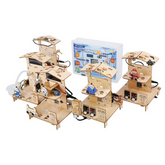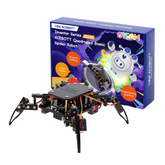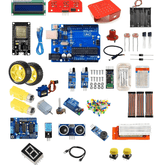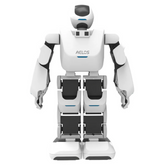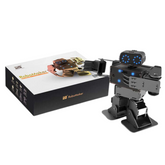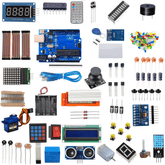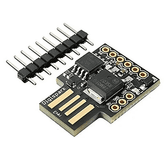How Robotics Labs Are Shaping STEM Education in Schools
Summary
The traditional classroom has undergone a remarkable transformation over the past decade. Where students once learned primarily through textbooks and lectures, today's educational landscape integrates cutting-edge technology that brings theoretical concepts to life.
Robotics labs in schools are one of the most significant developments in this evolution, fundamentally reshaping how students engage with STEM education.

What Are Robotics Labs and How Do They Work in Schools?
Robotics labs in schools are specialized learning environments where students interact with robotics kits, coding platforms, IoT sensors, and AI tools to design, build, and test functional robots.
Unlike conventional teaching methods that rely heavily on memorization, these labs encourage hands-on learning with robotics that transforms abstract concepts into tangible experiences.
A typical robotics lab setup for schools includes several key components that work together to create an immersive learning environment:
- Dedicated workspace: A well-ventilated area ranging from 400 to 1,200 square feet with proper lighting, electrical connections, and high-speed internet connectivity
- Robotics kits for schools: Age-appropriate equipment including motors, sensors, programmable microcontrollers, and assembly components that enable students to build functioning robots
- Programming stations: Computers or tablets equipped with coding software where students write and test programs that control robot behavior
- Testing areas: Designated spaces where students can observe their robots in action, troubleshoot issues, and refine their designs
These components combine subjects like science, technology, engineering, and mathematics with creativity and problem-solving.
For instance, when students build a robot that measures environmental conditions, they apply scientific principles while simultaneously engaging with mathematical calculations, programming logic, and engineering design.
The Role of Robotics in STEM Education

Robotics plays a transformative role in modern STEM education by bridging the gap between theoretical knowledge and practical application.
In robotics in modern classrooms, students witness abstract theories come alive through experimentation, fundamentally changing their relationship with learning.
The integration of robotics education addresses a critical need in today's tech-driven environment. Traditional teaching methods no longer adequately prepare students for the skills demanded in an increasingly automated world. Through robotics-based learning, students experience several paradigm shifts:
- They move from passive absorption of information to active participation in designing solutions
- They encounter failures as learning opportunities rather than setbacks, building resilience through iteration
- They see immediate connections between coding commands and physical robot responses, reinforcing cause-and-effect understanding
- They collaborate with peers to solve complex challenges that require diverse skill sets and perspectives
Robotics serves as a unifying force across STEM disciplines. When students program a robot to navigate obstacles, they simultaneously apply physics principles to understand motion, utilize mathematical concepts for calculations, employ engineering thinking for structural design, and develop technological literacy through coding.
This interdisciplinary approach demonstrates how different fields interconnect in real-world applications, preparing students for careers in automation and AI.
Key Benefits of Robotics Labs for Students
The implementation of STEM robotics labs for kids delivers substantial benefits that extend far beyond basic technical knowledge.
Research indicates that students involved in robotics education demonstrate higher STEM achievement scores and stronger interest in pursuing technology-related careers.
Enhanced Engagement and Motivation
Robotics transforms learning from a passive experience into an exploration adventure. When students see their programmed instructions translate into robot movements, they experience immediate feedback that reinforces understanding and maintains motivation.
This tangible connection between effort and result proves especially powerful for students who traditionally struggle with abstract concepts.
Development of Critical Thinking
Project-based learning with robots requires students to systematically approach challenges through:
- Analyzing problems by breaking them into manageable components
- Devising multiple potential solutions and evaluating their feasibility
- Testing hypotheses through hands-on experimentation with physical systems
- Troubleshooting malfunctions by identifying root causes and implementing fixes
- Optimizing performance through iterative refinement and data-driven adjustments
This systematic thinking approach proves valuable across all academic disciplines and real-life scenarios. The iterative process of testing, failing, and refining builds resilience and adaptability that serves students throughout their lives.
Cultivation of Creativity and Innovation
Designing robots encourages students to think beyond conventional solutions. When challenged to create a robot for specific functions, students must synthesize knowledge from multiple domains while exercising creativity in their approach.
This freedom to experiment and innovate nurtures the kind of entrepreneurial thinking increasingly valued in modern workplaces.
Preparation for Future Careers
With careers in robotics engineering, artificial intelligence, and automation rapidly expanding, early exposure through robotics for school students provides crucial preparation.
Students gain familiarity with technologies and methodologies that will define their professional futures, giving them significant advantages as they enter higher education and the workforce.
Skills Developed Through Robotics-Based Learning

STEM robotics workshops (link: https://academy.robocraze.com/) and regular robotics sessions cultivate a comprehensive skill set that defines 21st-century learning tools.
These competencies extend well beyond technical knowledge to encompass the soft skills essential for success in modern professional environments.
Collaboration and Teamwork
Robotics projects typically involve group work where students must coordinate their efforts toward shared objectives. This collaborative experience develops essential workplace competencies:
- Communication skills: Articulating ideas clearly, listening to teammates, and providing constructive feedback
- Division of labor: Identifying individual strengths and assigning responsibilities accordingly
- Conflict resolution: Navigating disagreements and finding compromise solutions when approaches differ
- Shared accountability: Taking collective responsibility for successes and setbacks
Team members might specialize in different aspects—programming, mechanical assembly, or testing—learning to integrate their specialized contributions into cohesive functioning systems. This mirrors contemporary workplace dynamics where cross-functional collaboration proves essential.
Computational and Logical Thinking
Programming robots teaches students to approach problems methodically, breaking complex challenges into manageable components and developing step-by-step solutions.
This computational thinking proves valuable across disciplines, enabling students to tackle various problems with structured, logical approaches that emphasize precision and sequential reasoning.
Technical Proficiency
Through regular interaction with robotics for students programs, learners develop fluency with:
- Programming languages, including Python, C++, and block-based coding platforms
- Engineering principles related to mechanics, electronics, and system design
- Mathematical problem-solving involving geometry, algebra, and measurement
- Technology literacy encompassing hardware-software integration and troubleshooting
This technical foundation prepares them for advanced studies and careers in increasingly digitized fields.
Adaptability and Resilience
Robotics projects rarely proceed perfectly on the first attempt. Students learn to view failures as learning opportunities, developing the persistence and adaptability necessary to overcome obstacles.
These qualities prove essential in academic pursuits and professional careers where challenges inevitably arise.
Integrating Robotics into School Curriculums
Successful integration of robotics curriculum for schools requires thoughtful planning and strategic implementation. Schools worldwide are discovering creative approaches to incorporating robotics education into existing academic frameworks.
Structured Robotics Periods
Many schools establish dedicated robotics classes as regular weekly sessions, similar to traditional subjects like science or mathematics.
These structured periods provide consistent exposure and allow progressive skill development throughout the academic year. Students advance from basic concepts to increasingly complex projects, building competence systematically.
STEM Laboratory Environments
Creating specialized STEM robotics labs for kids offers dedicated spaces designed specifically for exploration and experimentation. These laboratories feature:
- Workbenches and assembly areas equipped with necessary tools and materials
- Computing stations with programming software and simulation platforms
- Testing zones where robots can operate safely with adequate clearance
- Storage systems for organizing robotics kits for schools and component inventories
- Display areas showcasing student projects and achievements
These innovation hubs serve as spaces where students apply theoretical knowledge to practical projects under guidance and supervision.
Integration Across Subjects
Progressive schools weave robotics education throughout their curriculum rather than treating it as an isolated subject. This cross-curricular approach manifests in various ways:
- Mathematics classes incorporate programming challenges that require algebraic thinking and geometric calculations
- Science lessons involve sensor-based experiments measuring temperature, light, sound, or distance
- Technology courses naturally align with robotics applications including coding and system design
- Even language arts can integrate through technical writing assignments documenting robot designs and procedures
Extracurricular Programs
STEM robotics workshops, holiday camps, competition preparations, and robotics clubs offer additional opportunities for interested students to deepen their engagement.
These programs provide flexibility for schools still developing their core curriculum while offering enrichment for students passionate about robotics.
The Future of Robotics in STEM Education
The trajectory of integrating robotics in school programs points toward increasingly sophisticated and accessible learning experiences.
Emerging trends suggest that technologies involving automation and AI will continue reshaping educational approaches in profound ways.
Advanced AI Integration
Future robotics curriculum for schools will increasingly incorporate artificial intelligence, machine learning, and sophisticated automation concepts. Students will progress beyond basic programming to explore:
- Pattern recognition algorithms that enable robots to identify objects or classify data
- Decision-making systems that allow autonomous behavior based on environmental conditions
- Self-learning capabilities where robots improve performance through experience
- Natural language processing that facilitates human-robot communication
These advanced concepts will mirror real-world AI applications, preparing students for cutting-edge technological careers.
Expanded Accessibility
A growing movement aims to make robotics education available to underserved communities and schools with limited resources.
Through partnerships between technology companies, educational institutions, and nonprofit organizations, more students will gain access to transformative learning experiences regardless of geographic or economic circumstances.
Cloud-based platforms and affordable robotics kits are democratizing access to quality robotics education.
Industry Partnerships
Collaborations between schools and technology companies will create direct pathways into high-tech careers through robotics programs, internships, and mentorship opportunities.
These partnerships ensure that educational content remains relevant to industry needs while providing students with real-world connections that can translate into employment opportunities.
Evolution of Learning Tools
Technological advances continue enhancing how students interact with robotics education. Emerging developments include:
- 3D printing capabilities allowing students to design and fabricate custom robot components
- Augmented reality interfaces that visualize programming logic and robot sensor data
- Cloud-based collaboration platforms enabling students to work on projects remotely
- Modular robotics kits with expandable capabilities that grow with student skill levels
These technologies will enable more sophisticated projects while simultaneously reducing costs and improving accessibility.
Challenges Schools Face While Setting Up Robotics Labs
Despite the clear benefits of robotics in education, institutions encounter significant obstacles when establishing these facilities. Understanding and addressing these challenges proves essential for successful implementation.
Financial Constraints
The most substantial barrier involves the initial investment required for robotics lab setup for schools. Budget considerations include:
- Advanced robotic systems and AI-driven tools representing significant capital expenses
- Quality robotics kits suitable for different age groups and skill levels
- Infrastructure upgrades including high-speed internet, electrical outlets, and dedicated workspace
- Ongoing costs for software licenses, system maintenance, and component replacements
- Potential hiring of specialist instructors with robotics expertise
These expenses prove particularly challenging for schools in rural areas or underserved communities with limited budgets.
Teacher Training and Readiness
Many educators lack experience with robotics education, creating implementation challenges. Successful programs require comprehensive preparation:
- Professional development workshops teaching robotics fundamentals and pedagogy
- Ongoing technical support addressing equipment issues and curriculum questions
- Collaborative platforms where educators share best practices and lesson plans
- Time allocation for teachers to experiment with equipment before instructing students
- Building teacher confidence and competency proves essential for program success.
Curriculum Integration Complexity
Determining how to meaningfully incorporate robotics into existing academic structures while meeting educational standards presents another significant challenge.
Schools must balance traditional curriculum requirements with innovative learning approaches, requiring careful planning regarding scheduling, assessment methods, and learning outcome alignment.
To address these challenges, Robocraze offers comprehensive solutions for schools looking to establish or enhance their robotics programs.
With end-to-end support including curated robotics kits, teacher training programs, curriculum development assistance, and ongoing technical support, Robocraze helps schools overcome implementation barriers and successfully launch their STEM initiatives.
Conclusion
Robotics labs represent far more than technological additions to educational institutions. They fundamentally transform how students engage with learning, developing critical competencies that extend well beyond technical skills.
Through hands-on experimentation with physical systems, students cultivate creativity, collaboration, problem-solving abilities, and technological literacy essential for success in an increasingly automated world.
As these labs become standard features in schools worldwide, they will continue shaping the next generation of innovators, engineers, and critical thinkers.
The integration of robotics in education prepares students not merely to use technology but to understand, create, and ethically guide its development.
For educators, parents, and policymakers committed to preparing students for tomorrow's challenges, investment in robotics education represents one of the most impactful decisions they can make today.



